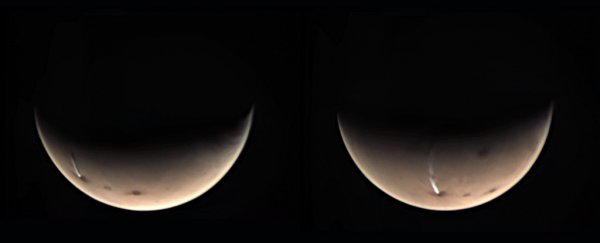Every good story deserves a sequel – and the strange white cloud spotted above an extinct Martian volcano back in 2018 just got one, because the stunning fog trail has made another appearance.
In fact, this is the latest instalment in a long-running series, and this time scientists were looking out expectantly for the event.
It's thought that the white plume is formed from dense air near the planet's surface getting forced uphill, where the temperature drops and the moisture condenses around dust particles.
It happens on Earth too: it's called orographic lift.
So this doesn't mean the long-dead Arsia Mons volcano is suddenly bursting back into life. But even though the cloud isn't associated with volcanic activity, it's still a stunning sight to behold.
"We have been investigating this intriguing phenomenon and were expecting to see such a cloud form around now," says physicist Jorge Hernandez-Bernal, from the University of the Basque Country in Spain.
"This elongated cloud forms every Martian year during this season around the southern solstice, and repeats for 80 days or even more, following a rapid daily cycle. However, we don't know yet if the clouds are always quite this impressive."
Hernandez-Bernal is part of a team using the Visual Monitoring Camera (VMC) on the Mars Express probe to keep an eye on the Red Planet. The spacecraft has been in orbit for the past 16 years, watching the changing seasons and days.
A Martian day lasts a little over 24 hours, while a year lasts about 687 days – hence this being the cloud's first appearance since 2018.
The cloud now has a name – it's being termed the Arsia Mons Elongated Cloud, or AMEC.
Based on observations so far, it can stretch out to about 1,800 kilometres (1,118 miles), which on Earth would get it almost half way across the US.
And the VMC is the perfect instrument to capture it with – the photos above were taken on 17 July and 19 July. While most spacecraft view Mars in the afternoon due to their orbits, Mars Express is also watching in the early mornings.
That's when this intriguing phenomenon appears, for about three hours at a time before disappearing. It also occurs during the southern solstice when the Sun is in the southernmost position in the Martian skies.
"The extent of this huge cloud can't be seen if your camera only has a narrow field of view, or if you're only observing in the afternoon," says planetary scientist Eleni Ravanis, working on the Mars Express mission at the European Space Agency.
"Luckily for Mars Express, the highly elliptical orbit of the spacecraft, coupled with the wide field of view of the VMC instrument, lets us take pictures covering a wide area of the planet in the early morning. That means we can catch it!"
Scientists are continuing to try and understand the AMEC and it's behaviour, but they've got a great vantage point.
You can see some of the stunning imagery that Mars Express has captured so far on Flickr.
